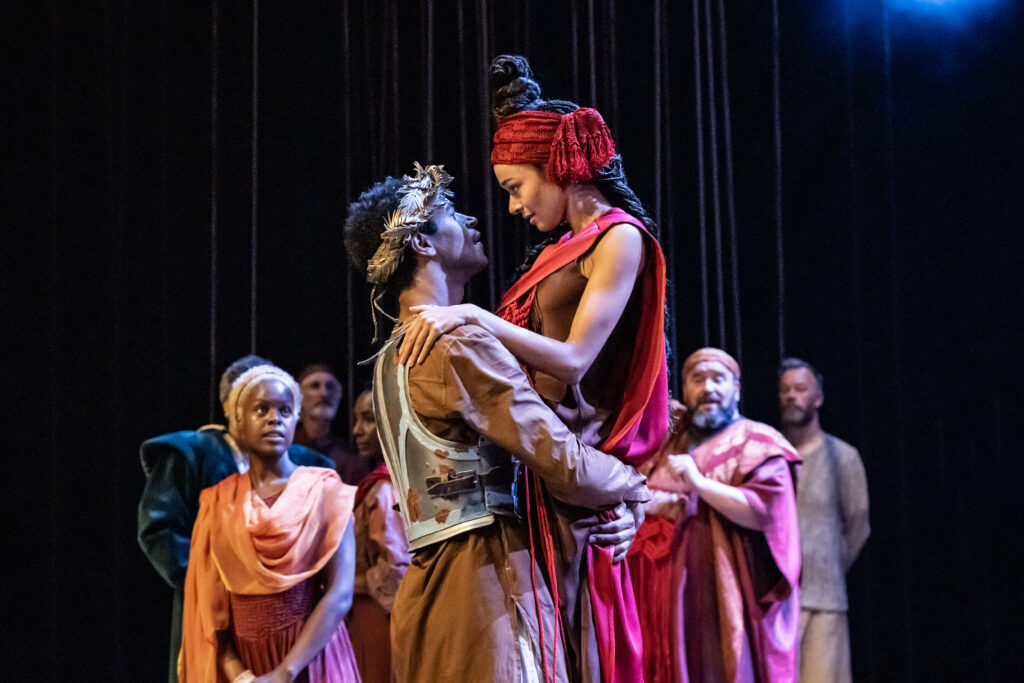Jessica Harris watches the RSC performing a Shakespearian soap opera.
With its convoluted plot, the comings and goings of Pericles would stand up any day against the storylines of our most popular TV soaps. An incestuous relationship between King Antioch and his daughter ends when both go up in the flames of a fire sent from heaven.
When Pericles’ wife, Thaisa, dies in childbirth on a ship, she is placed in a chest and thrown overboard, only to come back to life when the washed-up chest is found. Pericles himself stops speaking when he learns his daughter has died, but regains his voice when he is reunited with his daughter who is very much alive, and also with his wife.
It is down to the RSC to make sense of this can of worms, and it does so superbly in this production, bringing clarity to the plot and lucidity to its themes. As it takes us from ominous scenes of depravity to a finale full of joy and the love of a family reunited, it explores themes of power, virtue and honesty, shining a light on where good leadership is to be found – and it’s not always within those who hold the power.
Much of the appeal of this production of Pericles is down to its use of choreography. Slow movement and suspended animation by the cast emphasise an undercurrent of evil in the opening scenes in Antioch, whilst celebrations in Pentapolis are shown through more dynamic movements. Scenes of the starving people of Tarsus are enacted through physicality, as are the brothel scenes of Mytilene.
Antiochus’ hand on his daughter’s shoulder is a subtle portrayal of his abusive relationship with her whilst she, for much of the time, stands unspeaking in the centre of the stage. Sometimes, the image speaks more powerfully than the words.
The multiple locations are beautifully depicted through the use of costumes and lighting. In Antioch, colours of fuchsia, burgundy and plum dominate, whilst Tarsus brings gold and ochre to the fore, and Tyre is marked by teal and brown. The set is made up of parallel ropes hung high above stage and auditorium, signalling both the time that Pericles spends travelling by ship from one place to another and, perhaps, his ultimate triumph in escaping the ropes of fate which seem to bind him.
Music supports the production’s themes, moving from tones full of suspense to songs of pure sweetness which accompany love scenes.
There are points when the second act has less edge than the first. Marina (Rachelle Diedericks), bereft of both parents and threatened first with death and then dishonour, could have had a greater contrast with the role of the Chorus (also played, and played well, by Diedericks). Dionyza (performed on press night by Miriam O’Brien), envious, evil, and wanting to see Marina killed, could have shown rather more malice.
Helicanus (Philip Bird), advisor to Pericles, a truly good character and foil to those kings and governors who abuse their power, needed to draw the audience’s attention a little more. But, nevertheless, things are picked up by moments of great timing and humour, with Christian Patterson’s performance of Simonides contributing much to this.
Alfred Enoch gives a compelling performance of Pericles, his youthful face full of animation and his older version conveyed convincingly through gait and posture. Felix Hayes plays a menacing Antiochus, and also doubles very effectively in other roles. Leah Haile is strong as Thaisa, her facial expressions conveying where her heart lies.
All in all, this is a visual feast of a production which opens the can all the way on one of Shakespeare’s lesser-performed plays.
Pericles was directed by Tamara Harvey, costume design was by Kinnetia Isidore, lighting design by Ryan Day and set design by Jonathan Fensom.
It is on at Stratford until 21st September. For further information visit rsc.org.uk
Pics – Johan Persson (c) RSC
